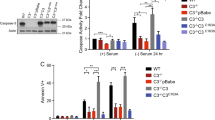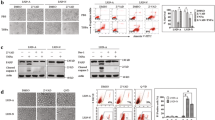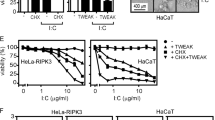Abstract
CTLL cells undergo apoptosis when cultured in the absence of IL-2. The IL-1β-converting-enzyme (ICE)/ caspase family has been implicated as an integral component of some forms of apoptosis. Numerous members of the caspase family have been identified, and it appears as if caspase-3/CPP32 plays a critical role. Previously we demonstrated that ICE/caspase-1 expression increases in CTLL cells during apoptosis; however, inhibition of ICE activity did not abrogate apoptotic death. The purpose of this report is to determine if other members of the caspase family are involved in T cell apoptosis induced by growth factor starvation. We show that cytosolic CPP32-like activity, as measured by the cleavage of DEVD-pNA and poly(ADP-ribose) polymerase (PARP), increases during apoptosis following growth factor deprivation. Cytosolic CPP32-like activity is inhibited in cells treated with the broad spectrum ICE family inhibitor boc-aspartyl(OMe)-fluoromethylketone (D-FMK) and by VAD-FMK and DEVD-FMK which have greater specificity for CPP32-like ICE homologs; however, only the broad spectrum ICE inhibitor D-FMK inhibited apoptosis. Our results suggest that apoptosis induced by growth factor deprivation involves the caspase family, but increased CPP32-like activity is not sufficient to mediate apoptosis induced by IL-2 starvation.
Similar content being viewed by others
References
Cohen J. Programmed cell death in the immune system. Adv Immunol 1991; 50: 55-85.
Lenardo M. Interleukin-2 programs mouse alpha beta T lymphocytes for apoptosis. Nature 1991; 353: 858-861.
Ameisen J, Capron A. Cell dysfunction and depletion in AIDS: the programmed cell death hypothesis. Immunol Today 1991; 12: 102-105.
Cheng J, Zhou T, Liu C, et al. A soluble form of the Fas molecule protects cells from Fas-mediated apoptosis. Science 1994; 263: 1759-1762.
Meyaard L, Otto S, Jonker R, Mijnster M, Keet R, Miedema F. Programmed death of T cells in HIV-1 infection. Science 1992; 257: 217-219.
Biedler D, Tewari M, Friesen P, Poirier G, Dixit V. The baculovirus p35 protein inhibits Fas-and tumor necrosis factor-induced apoptosis. J Biol Chem 1995; 270: 16526-16528.
Cain K, Inayat-Hussain S, Couet C, Cohen G. A cleavage-site-directed inhibitor of interleukin-1β-converting enzyme-like proteases inhibits apoptosis in primary cultures of rat hepatocytes. Biochem J 1996; 314: 27-32.
Gagliardini V, Fernandez P-A, Lee R, et al. Prevention of vertebrate neuronal death by the crmA gene. Science 1994; 263: 826-828.
Fearnhead H, Dinsdale D, Cohen G. An IL-1β-converting enzyme-like protease is a common mediator of apoptosis in thymocytes. FEBS Lett 1995; 375: 283-288.
Kumar S, Kinoshita M, Noda M, Copeland N, Jenkins N. Induction of apoptosis by the mouse Nedd2 gene, which encodes a protein similar to the product of the Caenorhabditis elegans cell death gene ced-3 and the mammalian IL-1β-converting enzyme. Genes Dev 1994; 8: 1613-1626.
Milligan C, Prevette D, Yaginuma H, et al. Peptide inhibitors of the ICE protease family arrest programmed cell death of motorneurons in vivo and in vitro. Neuron 1995; 15: 385-393.
Enari M, Hug H, Nagata S. Involvement of an ICE-like protease in Fas-mediated apoptosis. Nature 1995; 375: 78-81.
Zhu H, Fearnhead H, Cohen G. An ICE-like protease is a common mediator of apoptosis induced by diverse stimuli in human monocytic THP.1 cells. FEBS Lett 1995; 374: 303-308.
Yuan J, Shaham S, Ledoux S, Ellis H, Horvitz H. The C. elegans cell death gene ced-3 encodes a protein similar to mammalian interleukin-1β-converting enzyme. Cell 1993; 75: 641-652.
Miura M, Friedlander R, Yuan J. Tumor necrosis factor-induced apoptosis is mediated by a CrmA-sensitive cell death pathway. Proc Natl Acad Sci USA 1995; 92: 8318-8322.
Schlegel J, Peters I, Orrenius S. Isolation and partial characterization of a protease involved in Fas-induced apoptosis. FEBS Lett 1995; 364: 139-142.
Slee E, Zhu H, Chow S, MacFarlane M, Nicholson D, Cohen G. Benzyloxycarbonyl-Val-Ala-Asp (OMe) fluoromethylketone (Z-VAD.FMK) inhibits apoptosis by blocking the processing of CPP32. Biochem J 1996; 315: 21-24.
Xue D, Shaham S, Horvitz H. The Caenorhabditis elegans cell-death protein CED-3 is a cysteine protease with substrate specificities similar to those of the human CPP32 protease. Genes Dev 1996; 10: 1073-1083.
Jacobson M, Weil M, Raf M. Role of Ced-3/ICE-family proteases in staurosporine-induced programmed cell death. J Cell Biol 1996; 133: 1041-1051.
Wang L, Miura M, Bergeron L, Zhu H, Yuan J. Ich-1, an Ice/ced-3-related gene, encodes both positive and negative regulators of programmed cell death. Cell 1994; 78: 739-750.
Wang S, Miura M, Jung Y-K, et al. Identification and characterization of Ich-3, a member of the interleukin-1β-converting enzyme (ICE)/Ced-3 family and an upstream regulator of ICE. J Biol Chem 1996; 271: 20580-20587.
Mashima T, Naito M, Kataoka S, Kawai H, Tsuruo T. Aspartate-based inhibitor of interleukin-1β-converting enzyme prevents antitumor agent-induced apoptosis in human myeloid leukemia U937 cells. Biochem Biophys Res Com 1995; 209: 907-915.
Hasegawa J, Kamada S, Kamiike W, et al. Involvement of CPP32/Yama(-like) proteases in Fas-mediated apoptosis. Cancer Res 1996; 56: 1713-1718.
Nicholson D, Ali A, Thornberry N, et al. Identification and inhibition of the ICE/CED-3 protease necessary for mammalian apoptosis. Nature 1995; 376: 37-43.
Duan H, Chinnaiyan A, Hudson P, Wing J, He W, Dixit V. ICE-LAP3, a novel mammalian homologue of the Caenorhabditis elegans cell death protein Ced-3 is activated during Fas-and tumor necrosis factor-induced apoptosis. J Biol Chem 1996; 271: 1621-1625.
Duan H, Orth K, Chinnaiyan A, et al. ICE-Lap6, a novel member of the ICE/Ced-3 gene family, is activated by the cytotoxic T cell protease granzyme B. J Biol Chem 1996; 271: 16720-16724.
Faucheu C, Diu A, Chan A, et al. A novel human protease similar to the interleukin-1β converting enzyme induces apoptosis in transfected cells. EMBO J 1995; 14: 1914-1922.
Faucheu C, Blanchet AM, Collard-Dutilleul V, Lalanne JL, Diu-Hercend A. Identification of a cysteine protease closely related to interleukin-1β-converting enzyme. Eur J Biochem 1996; 236: 207-213.
Fernandes-Alnemri T, Litwack, G, Alnemri E. Mch2, a new member of the apoptotic Ced-3/Ice cysteine protease gene family. Cancer Res 1995; 55: 2737-2742.
Fernandes-Alnemri T, Takahashi A, Armstrong R, et al. Mch3, a novel human apoptotic cysteine protease related to CPP32. Cancer Res 1996; 55: 6045-6052.
Kamens J, Paskind M, Hugunin M, et al. Identification and characterization of ICH-2, a novel member of the interleukin-1β-converting enzyme family of cysteine proteases. J Biol Chem 1995; 270: 15250-15256.
Lippke J, Gu Y, Sarnecki C, Caron P, M Su. Identification and characterization of CPP32/Mch2 homolog 1, a novel cysteine protease similar to CPP32. J Biol Chem 1996; 271: 1825-1828.
Pai J, Brown M, Goldstein J. Purification and cDNA cloning of a second apoptosis-related cysteine protease that cleaves and activates sterol regulatory element binding proteins. Proc Natl Acad Sci USA 1996; 93: 5437-5442.
Wang X, Pai J, Wiedenfeld E, et al. Purification of an interleukin-1β converting enzyme-related cysteine protease that cleaves sterol regulatory element-binding proteins between the leucine zipper and transmembrane domains. J Biol Chem 1995; 270: 18044-18050.
Na S, Chuang TS, Cunningham A, et al. D4-GDI, a substrate of CPP32, is proteolyzed during Fas-induced apoptosis. J Biol Chem 1996; 271: 11209-11213.
Nath R, Raser K, Stafford D, et al. Non-erythroid α-spectrin breakdown by calpain and interleukin 1β-converting-enzyme-like protease(s) in apoptotic cells: contributory roles of both protease families in neuronal apoptosis. Biochem J 1996; 319: 683-690.
Tewari M, Quan L, O'Rourke K, et al. Yama/CPP32β, a mammalian homolog of CED-3, is a crmA-inhibitable protease that cleaves the death substrate poly(ADP-ribose) polymerase. Cell 1995; 81: 801-809.
Casiola-Rosen L, Nicholson D, Chong T, et al. Apopain/CPP32 cleaves proteins that are essential for cellular repair: A fundamental principle of apoptotic death. J Exp Med 1996; 183: 1957-1964.
Darmon A, Nicholson D, Bleackley R. Activation of the apoptotic protease CPP32 by cytotoxic T-cell-derived granzyme B. Nature 1995; 377: 446-448.
Duke R, Cohen J. IL-2 addiction: withdrawal of growth factor activates a suicide program in dependent T cells. Lymphokine Res 1986; 5: 289-299.
Deng G, Podack E. Suppression of apoptosis in a cytotoxic T-cell line by interleukin 2-mediated gene transcription and deregulated expression of the proto-oncogene bcl-2. Proc Natl Acad Sci USA 1993; 90: 2189-2193.
Vasilakos J, Ghayur T, Carroll R, et al. IL-1β converting enzyme (ICE) is not required for apoptosis induced by lymphokine deprivation in an IL-2-dependent T cell line. J Immunol 1995; 155: 3433-3442.
Schlegel J, Peters I, Orrenius S, et al. CPP32/apopain is a key interleukin-1β converting enzyme-like protease involved in Fas-mediated apoptosis. J Biol Chem 1996; 271: 1841-1844.
Bump N, Hackett M, Hugunin M, et al. Inhibition of ICE family proteases by baculovirus antiapoptotic protein p35. Science 1995; 269: 1885-1888.
Schmaier A, Bradford H, Lundberg D, Farber A, Colman R. Membrane expression of platelet calpain. Blood 1990; 75: 1273-1281.
Chu-Ping M, Slaughter C, DeMartino G. Purification and Characterization of a protein inhibitor of the 20S proteasome (macropain). Biochem Biophys Acta 1992; 1119: 303-311.
Schulze-Osthoff K, Krammer P, Droge W. Divergent signaling via APO-1/Fas and the TNF receptor, two homologous molecules involved in physiological cell death. EMBO J 1994; 13: 4587-4596.
Kuida K, Lippke J, Ku G, et al. Altered cytokine export and apoptosis in mice deficient in IL-1β converting enzyme. Science 1995; 267: 2000-2003.
Thornberry N, Bull H, Calaycay J, et al. A novel heterodimeric cysteine protease is required for interleukin-1β processing in monocytes. Nature 1992; 356: 768-774.
Fernandes-Alnemri T, Litwack G, Alnemri E. CPP32, a novel human apoptotic protein with homology to Caenorhabditis elegans cell death protein Ced-3 and mammalian interleukin-1β-converting enzyme. J Biol Chem 1994; 269: 30761-30764.
Kaufmann S, Desnoyers S, Ottaviano Y, Davidson N, Poirier G. Specific proteolytic cleavage of poly(ADP-ribose) polymerase: an early marker of chemotherapy-induced apoptosis. Cancer Res 1993; 53: 3976-3985.
Lazebnik Y, Kaufmann S, Desnoyers S, Poirier G, Earnshaw W. Cleavage of poly(ADP-ribose) polymerase by a proteinase with properties like ICE. Nature 1994; 371: 346-347.
Armstrong R, Aja T, Xiang J, et al. Fas-induced activation of the cell death-related protease CPP32 is inhibited by Bcl-2 and by ICE family protease inhibitors. J Biol Chem 1996; 271: 16850-16855.
Deshmukh M, Vasilakos J, Deckwerth T, Lampe P, Shivers B, Johnson E. Genetic and metabolic status of NGF-deprived sympathetic neurons saved by an inhibitor of ICE-family proteases. J Cell Biol 1996; 135: 1341-1354.
Boudreau N, Sympson C, Werb Z, Bissell M. Suppression of ICE and apoptosis in mammary epithelial cells by extracellular matrix. Science 1995; 267: 891-893.
Wilson K, Black J, Thompson J, et al. Structure and mechanism of interleukin-1β converting enzyme. Nature 1994; 370: 270-275.
Walker N, Talanian R, Brady K, et al. Crystal structure of the cysteine protease interleukin-1β-converting enzyme: a (p20/p10)2 homodimer. Cell 1994; 78: 343-352.
Rauber P, Angliker H, Walker B, Shaw E. The synthesis of peptidylfluoromethanes and their properties as inhibitors of serine proteinases and cysteine proteinases. Biochem J 1986; 239: 633-640.
Squier M, Miller A, Malkinson A, Cohen J. Calpain activation in apoptosis. J Cell Physiol 1994; 159: 229-237.
Enari M, Talanian R, Wong W, Nagata S. Sequential activation of ICE-like and CPP32-like proteases during Fas-mediated apoptosis. Nature 1996; 380: 723-726.
Miura M, Zhu H, Rotello R, Hartwieg E, Yuan J. Induction of apoptosis in fibroblasts by IL-1β converting enzyme, a mammalian homolog of the C. elegans cell death gene ced-3. Cell 1993; 75: 653-660.
Dolle R, Hoyer D, Prasad C, et al. P1 aspartate-based peptide alpha-((2,6-dichlorobenzoyl)oxy)methyl ketones as potent time-dependent inhibitors of interleukin-1β-converting enzyme. J Med Chem 1994; 37: 563-564.
Sarin A, Wu ML, Henkart P. Different interleukin-1 beta converting enzyme (ICE) family protease requirements for the apoptotic death of T lymphocytes triggered by diverse stimuli. J Exp Med 1996; 184: 2445-2450.
Martin S, Amarante-Mendes G, Shi L, et al. The cytotoxic cell protease granzyme B initiates apoptosis in a cell-free system by proteolytic processing and activation of the ICE/CED-3 family protease, CPP32, via a novel two-step mechanism. EMBO J 1996; 15: 2407-2416.
An S, Knox K. Ligation of CD40 rescues Ramos-Burkitt lymphoma B cells from calcium ionophore-and antigen receptor-triggered apoptosis by inhibiting activation of the cysteine protease CPP32/Yama and cleavage of its substrate PARP. FEBS Lett 1996; 386: 115-122.
Chow S, Weis M, Kaas G, Homstrom T, Eriksson J, Orrenius S. Involvement of multiple proteases during Fas-mediated apoptosis in T lymphocytes. FEBS Lett 1995; 364: 134-138.
Troy C, Stefanis L, Prochiantz A, Greene L, Shelanski M. The contrasting roles of ICE family proteases and interleukin-1β in apoptosis induced by trophic factor withdrawal and by copper/zinc superoxide dismutase down-regulation. Proc Natl Acad Sci USA 1996; 93: 5635-5640.
Kumar S. Inhibition of apoptosis by the expression of antisense Nedd2. FEBS Lett 1995; 368: 69-72.
Kuida K, Zheng T, Na S, et al. Decreased apoptosis in the brain and premature lethality in CPP32-deficient mice. Nature 1996; 384: 368-372.
Author information
Authors and Affiliations
Rights and permissions
About this article
Cite this article
Vasilakos, J.P., Lynch, T., Ghayur, T. et al. Caspase-3/CPP32-like activity is not sufficient to mediate apoptosis in an IL-2 dependent T cell line. Apoptosis 2, 289–303 (1997). https://doi.org/10.1023/A:1026489104188
Issue Date:
DOI: https://doi.org/10.1023/A:1026489104188




